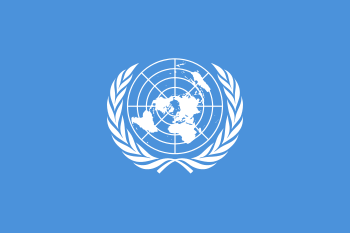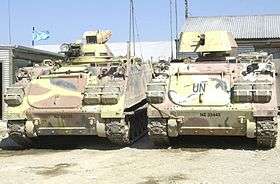United Nations Transitional Administration in East Timor
| East Timor | ||||||||||||
| Timór Lorosa'e Timor–Leste | ||||||||||||
| United Nations protectorate | ||||||||||||
| ||||||||||||
| ||||||||||||
 Location of East Timor at the end of the Indonesian archipelago. | ||||||||||||
| Capital | Dili | |||||||||||
| Languages | Tetum Portuguese Indonesian English | |||||||||||
| Political structure | United Nations protectorate | |||||||||||
| Transitional Administrator | Sérgio Vieira de Mello | |||||||||||
| Chief Minister | ||||||||||||
| • | 2001–2002 | Mari Alkatiri | ||||||||||
| History | ||||||||||||
| • | UN Security Council Resolution 1272 | 25 October 1999 | ||||||||||
| • | Independence | 20 May 2002 | ||||||||||
| Population | ||||||||||||
| • | est. | 947,000 | ||||||||||
| Currency | United States dollar | |||||||||||
| ||||||||||||
The United Nations Transitional Administration in East Timor (UNTAET) provided an interim civil administration and a peacekeeping mission in the territory of East Timor, from its establishment on 25 October 1999,[1] until its independence on 20 May 2002, following the outcome of the East Timor Special Autonomy Referendum. Security Council Resolution 1272 established the transitional administration in 1999, and its responsibilities included providing a peacekeeping force to maintain security and order; facilitating and co-ordinating relief assistance to East Timorese; facilitating emergency rehabilitation of physical infrastructure; administering East Timor and creating structures for sustainable governance and the rule of law; and assisting in the drafting of a new constitution and conducting elections.[2] It was led by Brazil's Sergio Vieira de Mello (Special Representative of the Secretary-General for East Timor) and the Philippines's Lieutenant General Jaime de los Santos (Supreme Commander of the United Nations' Peacekeeping Force (PKF)).
A coalition of nations sent troops to support the peace keeping mission. The forces were led by Australia, which provided the largest contingent and the out of theatre base for operations, supported by New Zealand, who sent the second largest contingent, and took responsibility for the more volatile southern half of the main border, France, whose special forces joined the ANZACs on the first day, as well as contingents from Brazil, Canada, Denmark, Fiji, Kenya, Ireland, Japan, Malaysia, Singapore, South Korea, Thailand, the Philippines, Portugal, Sweden, and the United Kingdom. While the United States supported the transition authority, it did so mainly by underwriting contracts to replace destroyed infrastructure and thus avoided a direct military involvement, allowing the ANZAC led force to take the lead. The United States did, however, deploy a contingent of American police officers to serve with the International Police.
UNTAET was established on 25 October 1999, and was abolished on 20 May 2002, with most functions passed to the East Timor government. The military and police forces were transferred to the newly created United Nations Mission of Support to East Timor (UNMISET).
Initial administrative structures
A National Consultative Council was established in December 1999 by UNTAET REG 1999/2,[3] and served as a forum for East Timorese political and community leaders to advise the Transitional Administrator and discuss policy issues. The Council had eleven Timorese members and four international members. A Transitional Judicial Service Commission was also established to ensure representation of East Timorese leaders in decisions affecting the judiciary in East Timor. The Commission was made up of three Timorese representatives and two international experts.[4] Security was initially provided by the International Force for East Timor (INTERFET) but was assumed by UNTAET Peace-Keeping Force (PKF) in February 2000. Law and order was maintained by a United Nations Civilian Police Force (CIVPOL) until an East Timorese Police Service was established in April 2000.
Part of a series on the |
|---|
| History of East Timor |
 |
| Chronology |
| Topics |
|
|
First Transitional Administration
In July 2000 the membership of the National Consultative Council was expanded to 36 members including, one representative from each of the 13 districts of East Timor, and the body was renamed the National Council.[5] All the members were now Timorese and represented the main political parties and religious communities of East Timor. The National Council became a legislature style body and had the right to debate any future regulations issued by UNTAET.
The following month an executive body, the Transitional Cabinet of East Timor, was formed comprising four Timorese members and four international members.[6]
Progress was made in the development of a judicial system with a Prosecutor General's Office and a Defender Service established. District Courts and Court of Appeal were also established.
In September 2000, the Transitional Cabinet approves the establishment of an East Timor Defence Force. The force was formally established in February 2001[7] and the guerrilla movement FALINTIL was officially disbanded with many of its members joining the new force.
A voter registration process was completed during this period and preparations were made for elections to a Constituent Assembly that would prepare East Timor for independence expected in 2002.
Second Transitional Administration
Elections for an 88-member Constituent Assembly[8] were held on 30 August 2001, the second anniversary of the autonomy referendum, which resulted in a plurality of seats for the FRETALIN party. The Assembly nominated a transitional Council of Ministers[9] the following month. The Council of Ministers had 24 members and was led by transitional Chief Minister Mari Alkatiri.
The Constituent Assembly completed work on a draft constitution and this was promulgated in March 2002,[10] the Assembly would serve as the parliament of East Timor following independence.
Presidential elections were held in April in which Xanana Gusmão was elected president of a future independent East Timor.
East Timor became an independent state on 20 May 2002.
Post Independence
UNTAET was wound up upon East Timorese independence but a United Nations presence in East Timor would continue through a newly established The United Nations Mission of Support in East Timor (UNMISET).
See also
- International Force for East Timor
- Timeline of UN peacekeeping missions
- UN protectorate
- United Nations Interim Administration Mission in Kosovo, a similar arrangement for Kosovo
- UNTAET Crime Scene Detachment
References
- ↑ United Nations Security Council Resolution 1272. S/RES/1272(1999) (1999) Retrieved 12 April 2008.
- ↑ Archived 23 December 2009 at the Wayback Machine.
- ↑ "United Nations". Un.org. Retrieved 27 December 2012.
- ↑ "United Nations". Un.org. Retrieved 27 December 2012.
- ↑ "United Nations" (PDF). Un.org. Retrieved 27 December 2012.
- ↑ "United Nations" (PDF). Un.org. Retrieved 27 December 2012.
- ↑ "United Nations". Un.org. Retrieved 27 December 2012.
- ↑ "United Nations" (PDF). Un.org. Retrieved 27 December 2012.
- ↑ "United Nations" (PDF). Un.org. Retrieved 27 December 2012.
- ↑ "constitution.org". constitution.org. Retrieved 27 December 2012.
Further reading
- Goldstone, Anthony (2004). "UNTAET with Hindsight: The Peculiarities of Politics in an Incomplete State". Global Governance: 83–98.
- Martin, Ian; Alexander Mayer-Rieckh (Spring 2005). "The United Nations and East Timor: From Self-Determination to State-Building". International Peacekeeping. 12 (1): 125–145. doi:10.1080/1353331042000286595.
External links
| Wikimedia Commons has media related to UN-Missions in East Timor. |
- Archived official website
- The United Nations and East Timor - A Chronology
- UNTAET Mission Summary
- A Brief History of Australian Army Operations in East Timor, 1999-2005
- Archived web-site of first Transitional Administration
- Archived web-site of second Transitional Administration

.svg.png)
